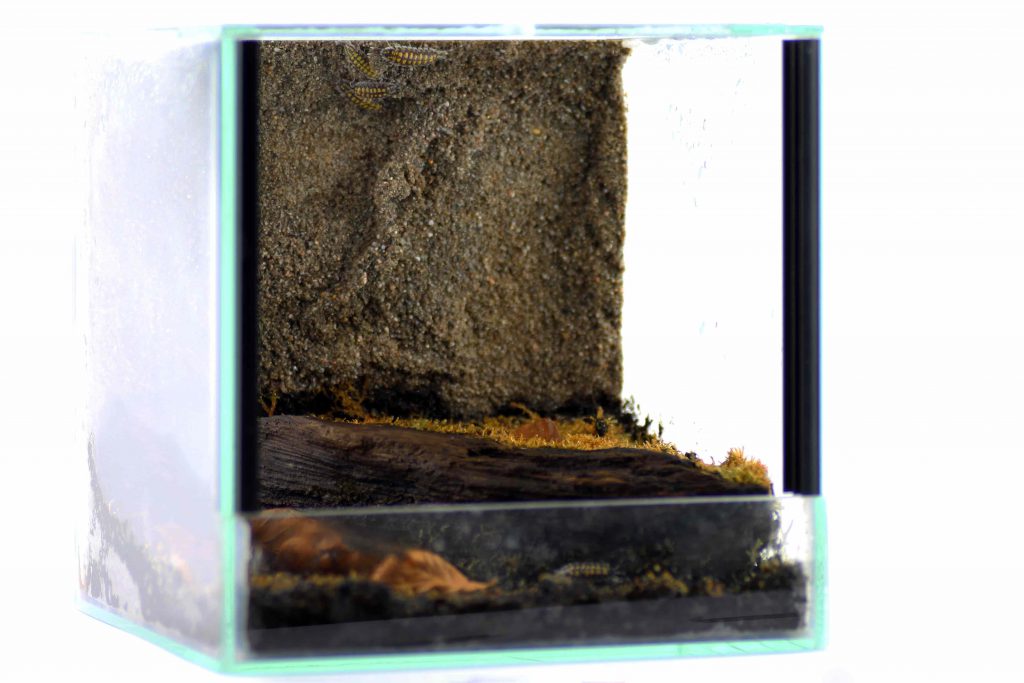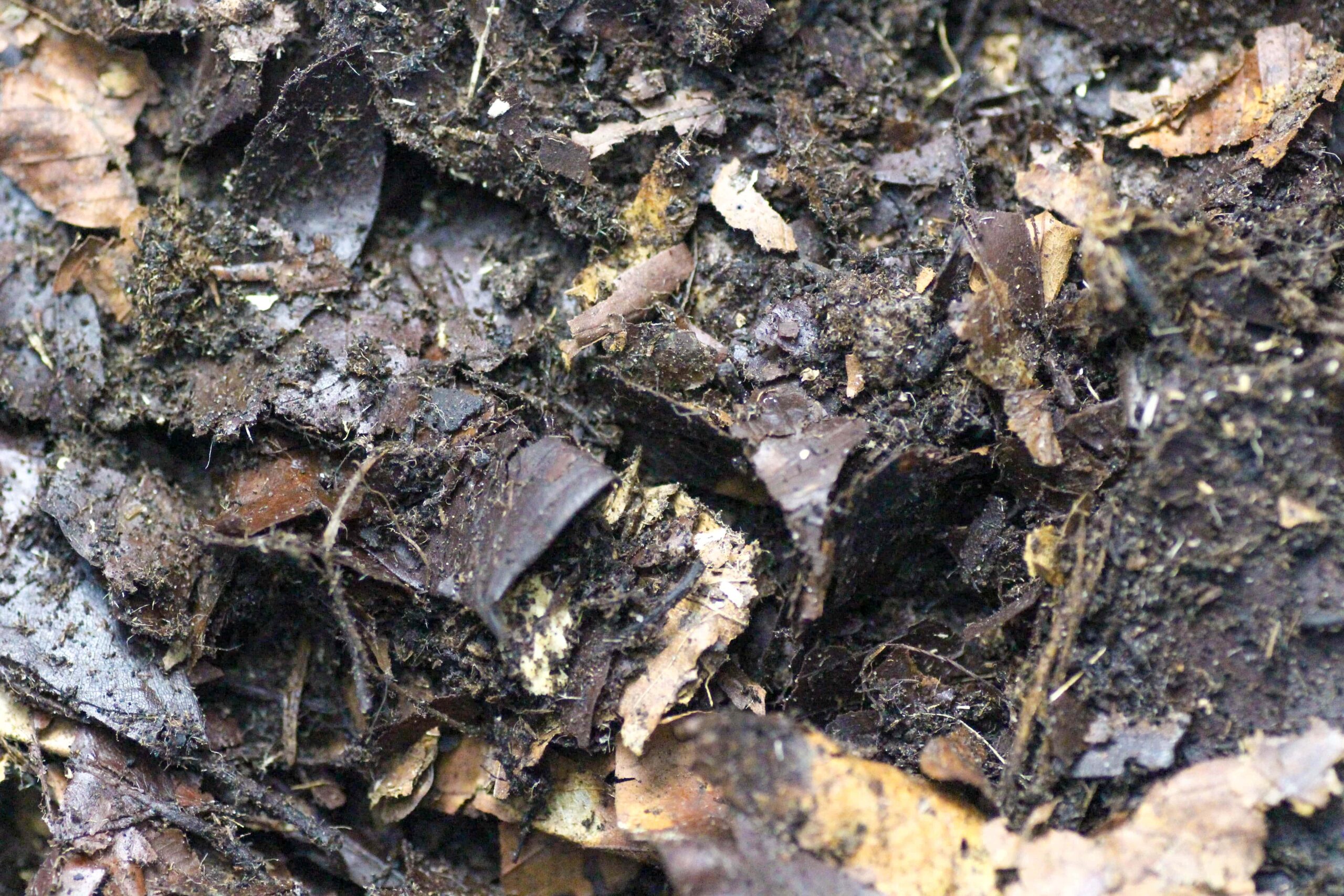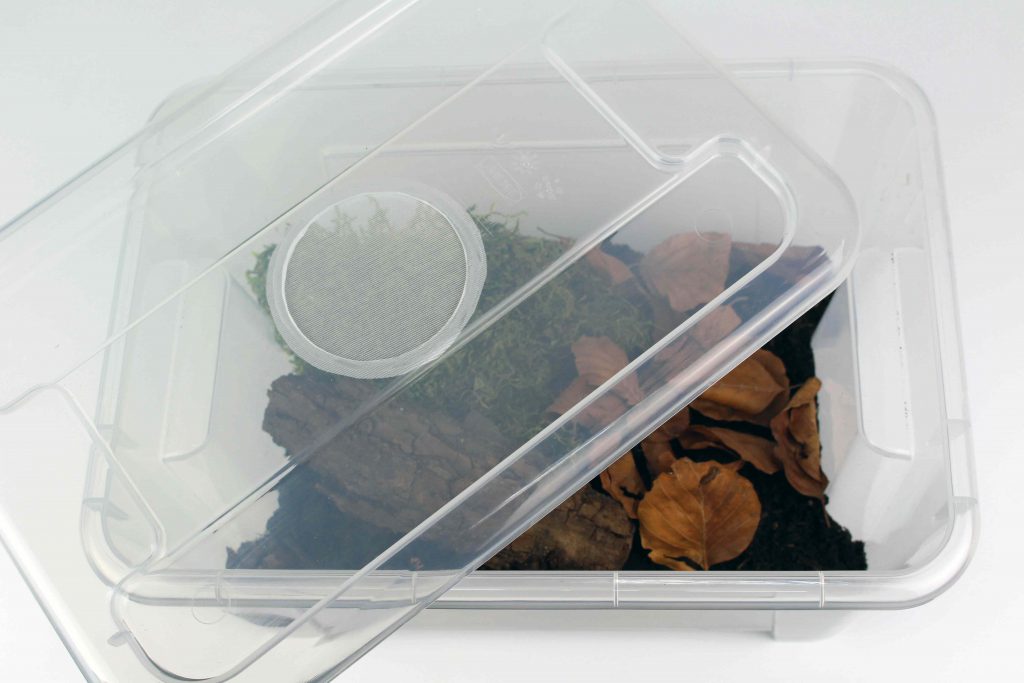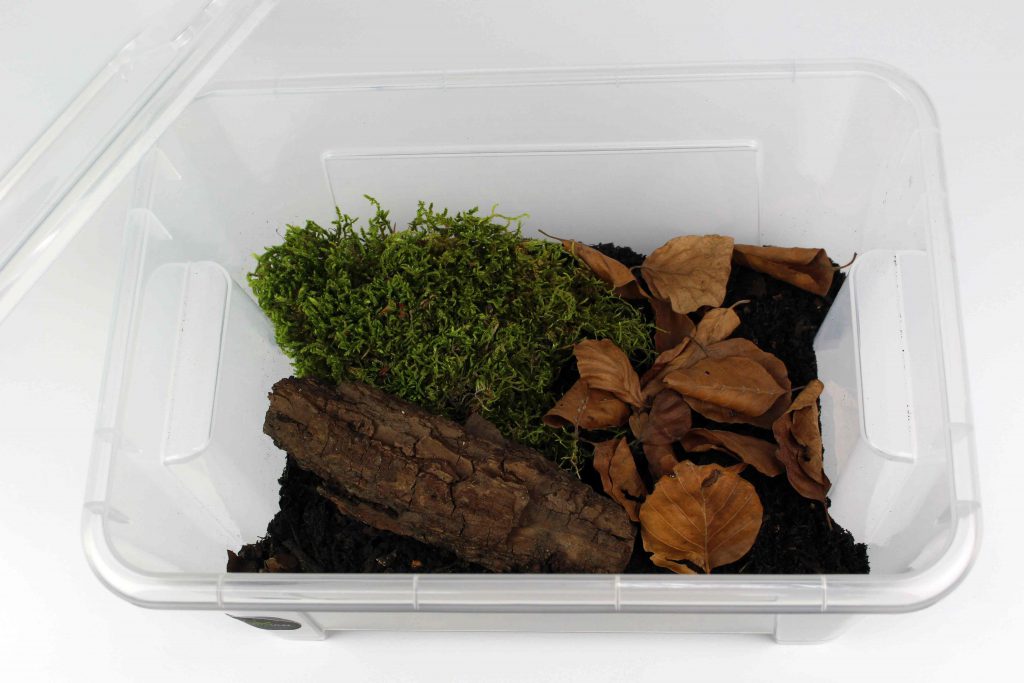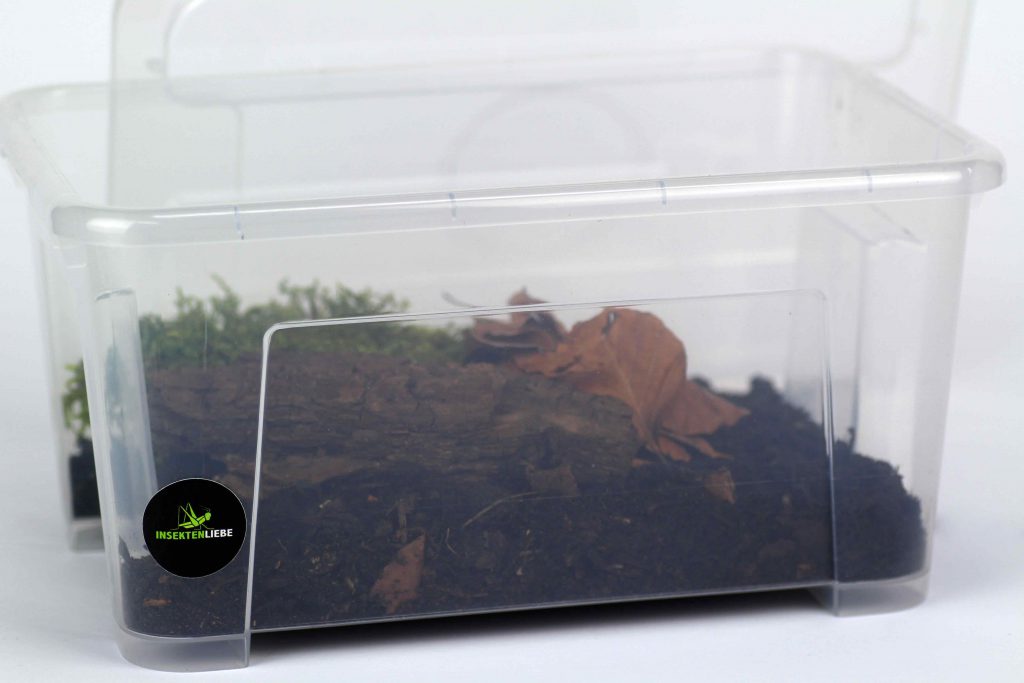Once the decision has been made to purchase isopods and design a terrarium for them, newcomers in particular will be faced with numerous questions. It is certain that isopods are kept in groups – at least twelve, better more animals should find a home with the new owner.
However, before you can start putting the animals into the terrarium, you need to make preparations: A suitable housing with a species-appropriate ground and suitable utensils must be selected. This is followed by a short running-in phase during which the substrate can acclimatise to the later inhabitants. The following section tells you what you need to know about the individual steps involved in providing an isopod terrarium.
The right size for an isopod terrarium
Woodlice are relatively undemanding animals and can also be kept in a very small terrarium. When I started keeping isopods, I used boxes with a capacity of 1.3 litres. This makes a very favorable entrance possible into the fascinating hobby.
However, I quickly realized that larger containers from 5 liters are much more attractive for me and the animals. A larger isopod terrarium offers more freedom of design and enables better observation of the behaviour of the interesting animals. In addition, it is much easier to maintain the necessary keeping parameters, which include a dry and a wet part, constantly. Since, at least with the pillbug species, offsprings are quickly to be expected, a larger terrarium pays off quickly.
The material of an isopod terrarium
Since isopods are very good climbers, one should fall back on a smooth material. Of course, aquariums are also suitable as accommodation, but you should make sure that there is a lid that closes well, as the isopods can climb along the silicone joint without any problems. In general, the housing should be provided with a well closing lid. This lid keeps the animals in their terrarium and increases the humidity in the terrarium.
Glass terrariums can also be used as dwellings. I advise you not to use sliding doors, because young animals can get outside unhindered between the panes. Therefore one should fall back on well closing trapdoor terrariums. Some isopod owners also use wooden terrariums. These must be treated with epoxy resin beforehand, so that the humidity cannot penetrate into the wood and damage this in the long run then.
Whether the effort, which one must operate for it, the use for it justifies I cannot judge, since I collected no experiences with it.
The disadvantage of glass terrariums compared to plastic boxes or wooden terrariums is obvious. They cannot be stacked on the basis the ventilation surfaces attached above as well as. The processing is a lot more difficult than with plastic and therefore you can’t improve the ventilation or make your work easier. Therefore I only use good closing plastic boxes.
At the end of the day it doesn’t matter which material the terrarium is made of, they will thrive with all kinds of material. It is much more important to provide sufficient ventilation.
Ventilation for the isopod terrarium
Without ventilation, the terrarium would sooner or later become a musty and mouldy shelter. Therefore it is very important that an oxygen exchange can take place to a certain extent. However, only up to a certain degree, since a too large ventilation area also lowers the humidity in the isopod terrarium at the same time and can lead to a dehydration of the small crustaceans. Therefore I advise against a so-called chimney ventilation with containers under 25 litres. This provides permanently for a draught and if one looks at the habitat of the animals in nature, this does not take place in the forest under rotten wood or foliage definitely.
I have noticed that it is completely sufficient to attach a ventilation area to the terrarium. For Porcellio species the ventilation should be slightly larger than for Armadillidium species. Porcellio species occur in nature in drier and thus also in a lower humidity than rollassels. Therefore, they thrive much better with larger ventilation areas.
In general I can’t give you a formula how big the aeration area should be, because the terrarium volume, the substrate height and the temperature have a decisive influence on the oxygen exchange in the isopod tank. My experience at the beginning was that it is advisable to use.
My experience at the beginning was that it is advisable to start with a larger ventilation area and then slowly screw it down by masking it until the optimal size is found. By “optimum size” I mean that the soil substrate still has slightly moist spots after a week, it does not mold and the air in the terrarium does not smell musty.
We attach a ventilation area of 6 cm diameter to our 5 litre
isopod starter sets. This size is a good compromise and is excellently accepted by all types of isopods. If you want to attach the ventilation to your terrarium yourself, you should make sure to attach a very fine-meshed ventilation grid.
This prevents the penetration of many pests such as mourning flies or fruit flies. Fine-meshed wire gauze or organza have proven to be very effective. They keep the intruders outside the box and in case flies should form in the accommodation due to offered fruit, vegetables, etc., also in the isopod terrarium.
Substrate in isopod terrarium – species-appropriate and functional
Once you have selected a suitable terrarium and adjusted the aeration, the question quickly arises how to set up the terrarium best so that the isopods and you can enjoy the new tank.
As far as substrate is concerned, no pesticides or fertilizers may be present, so the substrates available from the Garden Center are only suitable to a limited extent. Organic compost or potting soil is the final result after the isopods have used the vegetable waste. Therefore, they do not offer any added value for the woodlice. The small animals are constantly on the lookout for food and comb through the entire substrate. The best thing to offer the isopods is what they also prefer in nature: deciduous
forest humus. There they find the varied food they need. I only use resinous soil from coniferous forests for the Oniscus asellus (woodlouse) as it is the only species I have found in such areas so far. All other species have digestive problems due to the resinous substrate.
We treat the deciduous forest humus with heat in the microwave before using it. This prevents invasions by uninvited guests in a secluded habitat where we only want to keep isopods. Because the heat unfortunately also kills the useful animals like native springtails, we inoculate the substrate with
tropical springtails. These do not multiply as much as the native species and keep mould spores in check.
Substrate Calculator
Automatically calculates how many litres of forest humus and lime granulate you need for your container!
Substrate Calculator
Since one encounters more isopods in nature on calcareous soil, I enrich the approx. 5 cm high soil in the isopod terrarium with
lime granulate. This provides an important component for the structure of your exoskeleton and at the same time makes the soil airier. You can also add 10% sand to the substrate – which is not absolutely necessary. At the moment I only use sand for African species like Armadillidium officinalis “Israel”, Porcellio spinipes and Armadillidium spec. “Cameroon”.
White rotten wood is much more important than sand. With it, I enhance the forest leaf humus again with food and create a natural substrate. I use about 20% white rot wood and 80% forest leaf humus and mix the whole thing once.
If you have the time, it would be advantageous if you observe the ground with the springtails and the newly installed ventilation for one to two weeks without isopods. This acclimatizes the substrate and the springtails and you get a feeling for the weekly addition of water without endangering the isopods. Especially if you don’t have any terraristic experience and don’t want to experience a setback at the beginning, this is a good way to get the necessary security.
But before that you can put on the furnishings and decorations.
Furnishings for the isopod terrarium
In addition to the substrate, hiding places must also be provided in the new terrarium so that the isopods can be offered a species-appropriate home. Almost all owners agree that pieces of bark in the terrarium create optimal hiding places for the isopods. The pieces should always be adapted to the size of the tank so that the assel terrarium is not completely covered and the inhabitants can still be well observed.
I use for the bark piece an area of approx. 1/5 of the floor area. So the isopods have enough space to hide and there is still some space left to put in a moss corner and food places. Alternatively one can also offer egg cartons as a hiding place. I use this for species that I control relatively often. Since the egg carton is much lighter than a piece of bark, there is no danger that the isopods will be crushed if you put the hiding place back on the ground. Of course this is not exactly what you would expect from a forest terrarium, so I wouldn’t use it for a display terrarium.
From a corner of the isopod terrarium one makes a so-called moss corner. This is the place that has to be moistened regularly. The moss stores the humidity very well and one creates with the moss corner a place in the terrarium, which the woodlice will visit before moulting. There they will find the optimal conditions and there will be no problems with the moulting. In nature you can find different mosses that you can use. However, you should inform yourself beforehand, as there are moss varieties that are under conservation. Please don’t be careless, because meanwhile 54 moss species are already extinct in Germany and 335 moss species are threatened with extinction or endangered. If I have found a beautiful unprotected species in the forest, I simply harvest a small piece, so that the population can regenerate there quickly.
Finally, I cover the bare areas on the ground with
leaves. I have had the best experiences with oak and beech leaves, as they rarely get moldy and also lower the pH value in the soil substrate. The leaves also prevent the soil from evaporating quickly and provide the isopods with a natural source of food that should never run out.
